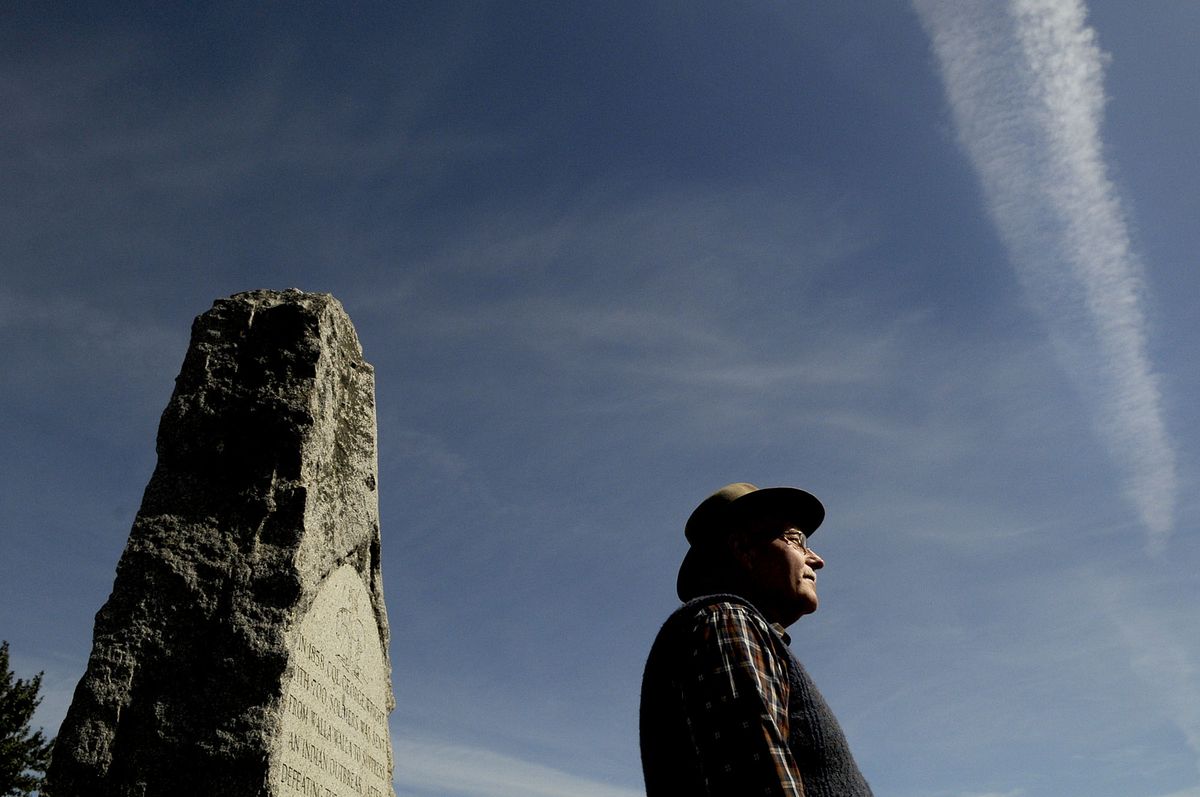Brutal act remembered
Gathering marks 150th anniversary of slaughter of Indian horses by Army colonel

A half-dozen people gathered Monday near the place where, exactly 150 years earlier, Army Col. George Wright ordered the slaughter of 800 Indian horses.
There was no ceremony for what is regarded as one of the most brutal acts of the Eastern Washington Indian wars. Just a question.
“Is there a chance we can bury the hatchet?” 70-year-old Harry Bright asked 61-year-old Frank SiJohn.
Bright, a Spokane resident, describes himself as “one of the people that came here thanks to Col. Wright doing his dirty work.”
“I think it’s regrettable,” said Bright, a history buff who helped prepare the firearms collection at Spokane’s Museum of Arts and Culture.
He proposes a formal government apology to help heal what, for many Native Americans, is still an open wound.
“If they said anything, I would cry,” said SiJohn, a grandson of Ignace Garry the last traditional chief of the Coeur d’Alene Tribe.
The federal government has apologized to other groups, but has been slow to respect Native Americans, SiJohn said.
He said his father, Isaac SiJohn, was forced into a boarding school and beaten for speaking his own language. And tribal members weren’t granted citizenship until the mid-1950s, SiJohn said.
The military campaign that led to the slaughter of Coeur d’Alene and Spokane tribal horses began when a couple of miners were killed after venturing into land the government said would remain closed to whites.
“We weren’t doing anything but fighting oppression,” SiJohn said. “We believed what they said, and there they came and spit in our face.”
SiJohn accepted Bright’s invitation to gather at a monument to the horse slaughter and contemplate “how things could go so wrong.”
Also present were Duane Broyles, president of the Fairmount Memorial Association and a member of the Westerners history club, and three members of a Loon Lake-area family.
Mary Engeldinger came with her sons, Chris and Aaron Engeldinger, who are working on a book about the Eastern Washington Indian wars and early white settlement.
All of those who gathered at the monument erected in 1946 by the Spokane County Pioneer Society agreed that an effort is needed to find the precise location of the horse slaughter.
SiJohn believes it is just across the Spokane River from the monument, which historical records indicate is at the site where Wright’s troops camped on Sept. 8, 1858.
Broyles said an Army spoon and animal bones possibly left from meal preparation were found when the Fairmount association and the Westerners restored the monument to its original location in June 2000.
Until well into the 20th century, there was no doubt about where the slaughter took place because the area gleamed with bleached bones.
“My dad nicknamed it White Horse Camp because, when you looked down on it (from nearby hills), it looked like a lake,” SiJohn said.
The 8-foot-tall granite marker, which had been moved about a mile east when Interstate 90 was built, now is at the edge of the Centennial Trail, about a half mile west of the I-90 weigh station near Stateline, Idaho.
The monument says Wright ordered the captured horses killed “to prevent the Indians from waging further warfare.”
Wright’s soldiers also burned tribal food in the sort of “scorched earth” campaign against civilians that the United States would soon wage in break-away states, SiJohn said.
“When they burned our provisions, they killed our elders and children,” he said. “We would have fought them man to man.”
At the time, both white and Indian cultures depended on horses, and killing them was shameful, SiJohn said.
“It was a hanging offense to steal a horse in those days,” he said. “Those horses were part of our lives.”
Wright acknowledged as much in a report he wrote on Sept. 10, 1858:
“I found myself embarrassed by those 800 horses. I could not hazard the experiment of moving with such a large number of animals (many of them very wild) along with my large train; should a stampede take place, we might not only lose our captured animals, but many of our own.
“Under those circumstances, I determined to kill them all, save a few for service in the quartermaster’s department and to replace broken down animals. I deeply regretted killing these poor creatures, but a dire necessity drove me to it.”
To many tribal members, though, the two-day slaughter was a surpassingly ruthless act that is still remembered bitterly.
Physically defeated Indians were then psychologically battered when Wright’s name was applied to monuments and institutions, SiJohn said.
He said he would like to erect a new memorial with an Indian perspective on the events of September 1858. But it’s a daunting challenge, given the need for state and tribal governments – not always on the best of terms – to work together.
Bright said he pledged his support when, after the others left Monday, he and SiJohn sat alone and talked for an hour and a half.